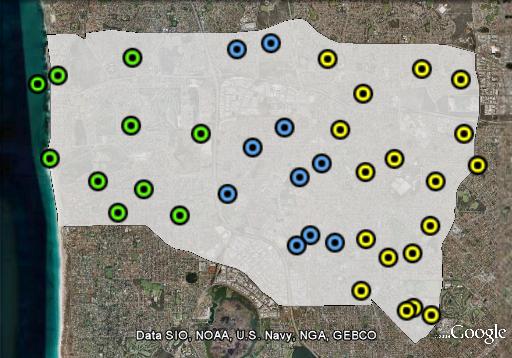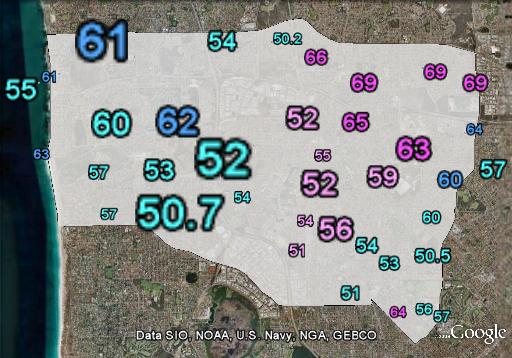LIB 1.3%
Incumbent MP
Michael Keenan, since 2004.
Geography
Northern suburbs of Perth. The seat covers most of the Stirling local government area. The seat stretches from Mirrabooka in the north-east, to Menora in the south-east, to Scarborough and Waterman on the west coast.
Redistribution
A number of suburbs were exchanged with neighbouring seats. Parts of Doubleview and Scarborough were transferred from Stirling to Curtin, while parts of Dianella were transferred to the seat of Perth. In exchange Stirling gained Joondanna from Curtin, Coolbinia and Menora from Perth and Waterman from Moore.
History
Stirling was first created for the 1955 election, and has always been a marginal electorate, with every member for the seat being defeated, with no-one serving in the seat for more than 11 years. Despite this seat being a marginal seat for half a century, the seat has often been held by Opposition members.
The seat was first won by Harry Webb of the ALP in 1955, when he moved from the nearby seat of Swan. Webb was defeated by Liberal Doug Cash in 1958, before winning it back in 1961. Ian Viner (LIB) won the seat in 1972, against the flow as Gough Whitlam won office. Viner held the seat for eleven years, serving as a minister in the Fraser government, as a junior minister from 1975 until 1980, when he joined the Cabinet.
Viner was defeated in 1983 by Ron Edwards (ALP), who was defeated in 1993 by radio presenter Eoin Cameron (LIB). Cameron lost to Jann McFarlane (ALP) in 1998. Like Cameron before her, McFarlane held the seat for two terms before losing in 2004 to Michael Keenan (LIB). Keenan was challenged in 2007 by former SAS officer Peter Tinley, who gained a small swing against Keenan, but not enough to win.
Candidates
- Chris Martin (Greens)
- Louise Durack (Labor)
- Elizabeth Re (Independent)
- Jenny Whately (Christian Democratic Party)
- Peter Clifford (Family First)
- Michael Keenan (Liberal) – Member for Stirling since 2004.
Political situation
The margin in Stirling is very slim despite practically no swing to the ALP in 2007. Any swing to the ALP in Western Australia makes this seat very vulnerable.
2007 result
| Candidate | Party | Votes | % | Swing |
| Michael Keenan | LIB | 38,220 | 47.21 | -0.05 |
| Peter Tinley | ALP | 32,737 | 40.44 | +1.50 |
| Tamara Desiatov | GRN | 6,123 | 7.56 | +0.41 |
| Ray Moran | CDP | 1,407 | 1.74 | -0.20 |
| Sam Ward | LDP | 666 | 0.82 | +0.82 |
| Denise Hynd | WWW | 590 | 0.73 | +0.73 |
| Symia Hopkinson | FF | 524 | 0.65 | +0.65 |
| Alex Patrick | ON | 524 | 0.65 | -0.82 |
| Keith Hallam | CEC | 160 | 0.20 | -0.71 |
2007 two-candidate-preferred result
| Candidate | Party | Votes | % | Swing |
| Michael Keenan | LIB | 41,520 | 51.29 | -0.75 |
| Peter Tinley | ALP | 39,431 | 48.71 | +0.75 |
Results do not take into consideration effects of the redistribution.
Booth breakdown
Quite strangely for a Perth electorate, Stirling lies entirely within a single local government area. In order to differentiate between booths, I have divided the electorate in three parts according to major north-south roads. “West” booths lie west of the Mitchell Freeway, while “East” booths lie east of Wanneroo Road, with “Central” booths lying between the two roads.
The ALP won most booths in the east of the seat, with the Liberals winning booths in the west, as well as a pocket of booths in the south-east.

| Voter group | GRN % | LIB 2CP % | Total votes | % of ordinary votes |
| East | 6.33 | 46.54 | 27,411 | 42.50 |
| West | 8.67 | 57.63 | 19,955 | 30.94 |
| Central | 6.69 | 49.45 | 17,136 | 26.57 |
| Other votes | 8.62 | 53.71 | 15,202 |



Stirling is a difficult seat for observers to understand – it’s more complex in character than possibly any other WA seat.
This is for a number of reasons. Firstly, a simplistic analysis yields a “west – Liberal, east – Labor” dichotomy along Wanneroo Road, but in fact the suburb of Yokine has always leaned Liberal, while Innaloo and Balcatta have sizable Labor votes. Secondly, it’s easy to assume that because Perth metro is growing at a rapid rate mostly from mining-related immigration, that Stirling is part of this. Stirling is for the most part a stable, even gradually declining, area over time with most of the growth occurring further north. Thirdly, any attempt to stereotype Stirling ignores the vast range of areas within it – it is a complete picture of mainstream urban Australia within one single electorate. And finally, subtle local-level trends are busily transforming the seat in ways which will probably end up cancelling each other out, but will probably long-term favour the Liberals. These trends are:
* Higher land prices meaning renters in Balcatta who voted Labor are likely moving to other areas beyond the electorate’s boundaries.
* Changes in the Scarborough area with younger, affluent, but less conservative people moving into apartments there.
* An “empty nester” effect in North Beach, Carine and Hamersley making those areas slowly trend more Labor without losing their Liberal tendency (although North Beach’s trend in this direction may be dented by the selling off of Homeswest stock near Marmion Avenue).
* New estates in Osborne Park and northern Dianella which have made those areas strong Liberal.
* Changing demographics in the poorer areas of Balga and Mirrabooka – the Aboriginal population have largely moved elsewhere while the Africans have moved in.
The apathy vote is actually very strong in Stirling, at least in part because of the ineffective nature of local media in the area (especially compared with Curtin, Perth and Fremantle to the south), and hence local issues tend to dominate elections in Stirling. The two contenders are Michael Keenan, the two-term Liberal MP and former Amanda Vanstone staffer who has never identifiably done anything for the area (and several community groups and the local council have suggested he claims credit for the work they actually do) but puts out regular newsletters and advertises all over the electorate on bus shelters, and Louise Durack, a disability officer who lives in the western part of the electorate. Both candidates are in their 30s, and both have been successful at getting stories into the local paper (to whatever extent anyone reads the 4 or 5 pages of local news it contains).
The Greens get a set 10% or so in the electorate (strongest in those empty nester areas and at Scarborough) but are neither seen nor heard apart from at elections. No other party ever does significantly well in Stirling – even One Nation flopped there during the 1998 election.
Areas which swung to the Liberals in 2007 were Trigg, due to dissatisfaction with the then-Labor state government over a local primary school; Osborne Park because of the demographic change I’ve described; and an area around Mirrabooka because of a Keenan/Howard pledge to build a bridge at a highway intersection nearby. All other areas swung to Labor. This did not quite correct for the 2004 swing, where working-class areas all over Perth swung heavily against Labor while wealthier areas went softly towards them.
What do I expect? As the apathy vote dominates, Labor will have to work hard to get its message out, particularly in the eastern part of the electorate; Keenan will have to show what he has actually achieved. And the Greens, no doubt, will put out a single brochure a few weeks before the election. But I think there may be just enough momentum in the overall electorate to get Labor over the line this time. I think Keenan benefitted last time from Howard being the incumbent PM – this time Labor is the incumbent, and that always matters when apathy rules and the stakes are as close as they are in Stirling. If I have time, I’ll write guides for the other northern suburbs electorates.
Can anyone please tell me what Keenan has done?
pippmc – opposed that rotten MRRT. That should be enough here.
Keenan is in more or less continuous campaign mode with billboards of his face everywhere. Increasing affluent electorate particularly in the big Scarborough booths. Will probably morph into a fairly safe Liberal electorate as time goes by.
Keenan’s non-stop advertising and recent letter drops (in the last 3 weeks my house has received about 10 letters) has been enough to ensure that I will not vote for him.
Luckily, I am not leaning towards Liberal’s current policies anyway so it isn’t a dilemma for me.
The sheer waste of paper that his campaign provides is perhaps his only contribution that I know of. The fact that his one-sided campaign letters are supposed to convince me is also a bit insulting. The same could be said for Labour I guess. The only party that has given me some half-informative reading was the Greens, where they actually outlined their policies without attacking or even mentioning any other party.
My prediction: 2-3% swing to Liberals.